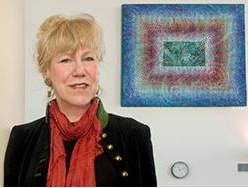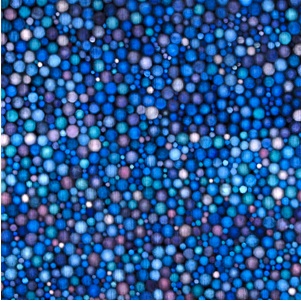
The National Institutes of Health Clinical Center, America’s research hospital, is located on the NIH campus in Bethesda, MD. The original Warren Grant Magnuson Clinical Center was built in 1953. It was replaced in September 2004 by the 870,000-square-foot Mark O. Hatfield Clinical Research Center, with 200 inpatient beds and 93 day-hospital stations. Fitzgerald Fine Arts (FFA) has worked with the Clinical Center (CC) since 1984 as fine art curators and consultants. The mission of the CC’s Art Program is to pair art with medicine to promote healing in an aesthetically pleasing environment for patients, visitors, and employees.
The 2,000 original works of art in the permanent collection primary focus on the local arts community. It reflects a diverse population and includes artwork of all media; fiber, watercolor, photography, glass, ceramic, calligraphy to large-scale contemporary paintings and folk art. In addition, the CC has six gallery spaces which change every eight weeks. A percentage of sales benefits the Patient Emergency Fund (PEF) which helps patients and families by providing short-term emergency funds during times of crisis or financial distress. Throughout the history of the program the galleries have raised $85,000.00 for the PEF.
FFA has negotiated donations, loans, and facilitated important commissions. We have designed exhibits exploring Clinical Center history and science, working in partnership with the NIH Stetten museum, the US Botanic Garden and the Smithsonian National Museum of Natural History. To accommodate special needs of both bio-hazard and mental health units FFA transferred images directly into wallcovering. We provided art that relaxed and soothed patients while maintaining a sterile, secure and safe environment. An extensive art program policy was created to document the mission, procedures and history of the Clinical Center Art program. We also created a walking tour brochure to give patients, staff and visitors more access to the permanent collection and the changing exhibits.
Gallery
National Institutes of Health Donations
The leading role NIH played and still does in the arts for healing generates many donations. FFA established procedures for artistic donations – how to submit, guidelines for acceptance, donor responsibilities. These procedures have been adopted by other government agencies and private facility
FFA transferred images to wall coverings for installation in extreme bio-hazard and mental health units where patients remain for extended periods of time and have special needs. FFA provided art that relaxed and soothed the bleakness of these units while maintaining a sterile, secure and safe environment.
News
Local Artist Inspired to Donate Painting After Sharing NIH Connection
Artist Carol Brown Goldberg understands the importance of art in an environment dedicated to healing and medicine. “I think it is the most important place to put art,” she said.
Goldberg donated her painting “If You Believe, You Get First Choice” to the Clinical Center in February.
Goldberg’s decision was motivated by a chance meeting with the parent of a former CC patient, who approached her at an exhibit of Goldberg’s artwork in December. Goldberg recalls feeling moved as the woman spoke of the time she spent at the CC praying for her son who was battling cancer.

Local artist Carol Brown Goldberg donated the painting pictured above titled “If You Believe, You Get First Choice,” to the CC this February. It hangs on the seventh floor of the Hatfield building.
“She said she wished she had been able to see that painting,” Goldberg said, “that maybe it would have helped her and given her a sense of optimism.”
Goldberg herself spent a significant amount of time at the CC in 1979 when her son underwen
t successful open heart surgery here. After her recent coincidental encounter with a fellow mother and caregiver, she decided to donate the painting.
“I was profoundly inspired by that conversation,” she said. “We are both so fortunate that our sons are healthy. The NIH and art brought us together quite serendipitously.”
Goldberg has been exhibiting in Washington, DC since 1975. Her work has been inspired by science, the brain, and physics, and she has been exploring the relationship between art and science for many years in a variety of mediums.
Her painting “If You Believe, You Get First Choice” hangs in the Hatfield Building seventh floor bridge.
Former Patient’s Art Explores Inner and Outer Landscapes
The most recent addition to the Clinical Center’s permanent art collection-a program to enhance the patient experience-comes from one of the target audience.
River Cells is an oil painting by former patient Paula Crawford, an associate professor of painting at George Mason University who has exhibited nationally and internationally.
“I’ve been an artist most of my adult life,” Crawford said. “That is what I’ve gotten up in the morning to do everyday.”
 Some of those days were spent in the CC to participate in a protocol under Dr. Y aron Rotman from the Liver Diseases Branch of the National Institute of Diabetes and Digestive and Kidney Diseases for treatment of chronic Hepatitis C. Crawford cited a contaminated gamma globulin shot received before a trip to Mexico as the probable source of her infection.
Some of those days were spent in the CC to participate in a protocol under Dr. Y aron Rotman from the Liver Diseases Branch of the National Institute of Diabetes and Digestive and Kidney Diseases for treatment of chronic Hepatitis C. Crawford cited a contaminated gamma globulin shot received before a trip to Mexico as the probable source of her infection.
Despite the taxing treatment regime, Crawford said, “I had the best medical care that I have ever experienced in my life … Everywhere at the Clinical Center-the liver clinic, phlebotomy, and elsewhere-! encountered a rare and unparalleled combination of organization, competence, and kindness.”
While around the building, her artist’s eye noticed the aesthetics. “The care to the physical building coupled with that of the doctors and staff become critical to a kind of total experience the patient receives.”
To add to the CC’s collection, Crawford painted River Cells in a few months. “I was trying to make a painting that both felt like watching river stones beneath rushing water (outside landscape), but also somewhat like looking through a microscope (interior landscape),” she said. The piece will hang in the Hatfield Building’s seventh floor breezeway.
“I hope that the art work inspires patients and co-workers the way Paula’s courage and determination inspired me,” Rotman said.
Art Donation Asks Viewers to ‘Apprehend This Miracles’
Premier local artist Jean Meisel made a generous donation to the Clinical Center this winter of 13 large works, half of which hang in the Magnuson’s Building new main corridor.
 Early last year Meisel mentioned to a contact at a Washington, DC, gallery that she had a wealth of paintings she’d like to share with those who couldn’t get out to see them and was told of the CC collection. Curator Lillian Fitzgerald visited Meisel’s Chevy Chase farmhouse and chose works she felt would fit the aesthetic of the hospital and create a cohesive showing. The oil paintings join the CC permanent collection, with seven works in the main corridor and six in the Hatfield Building’s fifth floor south wing.
Early last year Meisel mentioned to a contact at a Washington, DC, gallery that she had a wealth of paintings she’d like to share with those who couldn’t get out to see them and was told of the CC collection. Curator Lillian Fitzgerald visited Meisel’s Chevy Chase farmhouse and chose works she felt would fit the aesthetic of the hospital and create a cohesive showing. The oil paintings join the CC permanent collection, with seven works in the main corridor and six in the Hatfield Building’s fifth floor south wing.
The two groupings of Meisel’s work show a progression in her creative process. The artist studied English at the University of Michigan and did not start painting professionally until she moved to Georgetown with her young family in 1958. With three children, Meisel balanced motherhood with her work as a painter and a photographer, housing her dark room in the family’s downstairs bathroom. She grew quite successful, selling a number of her creations to corporate buyers and showing with The Washington Arts Museum, a non-profit to support local artists, and at the National Museum of Women in the Arts.
 A great source of inspiration for Meisel as her career progressed was the Phillips Collection in DC and particularly the works of abstract artists Milton Avery and Nicolas de Staël. “The complicated and interesting colors, simple shapes …” Meisel said. “It was just gorgeous. I thought, ‘I want to do that.’” Her work went from land and seascapes to color-blocks.
A great source of inspiration for Meisel as her career progressed was the Phillips Collection in DC and particularly the works of abstract artists Milton Avery and Nicolas de Staël. “The complicated and interesting colors, simple shapes …” Meisel said. “It was just gorgeous. I thought, ‘I want to do that.’” Her work went from land and seascapes to color-blocks.
After studying three early Italian painters—Giotto, Fra Angelico, and Piero della Francesca—Meisel’s work echoed the dark colors and architectural elements (abstract posts, checkerboards) of those premier artists. “I tried to convey that same sense of reverence and worth,” she said.
The pieces from this era of Meisel’s career—done in the 1970s—stand four-to-six feet high and just as wide. “If you had something to say, you were going to go big,” the artist said.
Her newer works play with black, a color Meisel sees not as depressing, but rather rich and distinguished. She has united her previous subjects, taking natural shapes from her landscape and seascape days and pairing them with the geometric forms.
Her artist’s statement explains: “Every day of our lives we are astounded by the glorious and mysterious objects and events in the natural world. In my paintings I isolate shapes and colors and simplify what I see—rocks, leaves, skies, shells—in the hope that the viewer, like the painter, can apprehend these miracles with new eyes.”




















